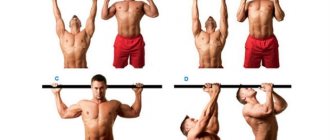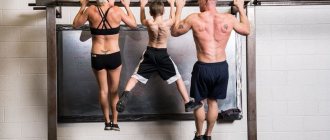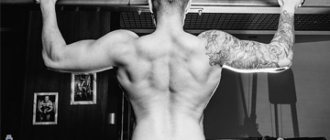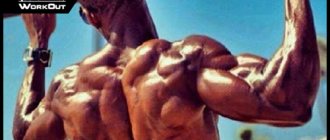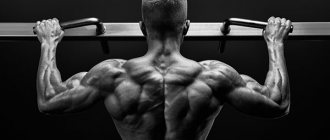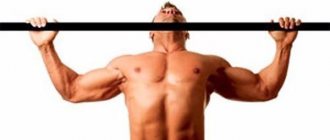The most effective way to get your body in shape is to exercise at the gym, however, not everyone has the extra money to buy a membership. Then exercises on the horizontal bar come to the rescue - it’s simple, and most importantly accessible. With the help of a horizontal bar you can work out all muscle groups, make your body more sculpted and toned. At the same time, for those who want to become more athletic and healthy, both complex exercises aimed at a large number of areas of the muscular skeleton and local exercises for specific areas are available.
Table of push-ups and pull-ups. Reverse and forward progression method
This table of pull-ups on the horizontal bar will help you achieve the desired result; you will be able to do at least 25 pull-ups.
Reverse progression method
You need to do pull-ups for 6 days; on the 7th, be sure to take a break from physical activity. You need to practice for 4 weeks, constantly changing your grip. In week 5, continue the training program using the direct progression method. Then you should return to the first version of the program.
Method diagram in table form
The presented training program is designed for beginners; in 5 weeks you can easily reach 25 times in 3 approaches. Those who have a standard significantly higher than the presented amount can catch up by doubling all the numbers in the table. This way you can learn to do it 30, 50 and 100 times, the main thing is desire and regular training.
There are two types of grip in pull-ups - forward and reverse.
With a direct grip, the fingers of the hands move away from you, with a reverse grip, they move towards you. If the hands are located at shoulder level - a narrow grip, 10 cm wider - medium, and if they are spread as far apart as possible - a wide grip.
Example program
Monday (back and biceps):
- Wide grip pull-ups - 2 sets.
- Pull-ups with a shoulder-width grip - 2 sets.
- Pull-ups with a narrow lower grip - 2 sets.
- Australian pull-ups - 1 set.
Tuesday (chest and triceps):
- Triceps dips - 3 sets.
- Chest dips - 3 sets.
- Universal push-ups - 1 set.
Wednesday: rest.
Thursday (back and biceps):
- Narrow grip pull-ups - 3 sets.
- Wide grip pull-ups - 3 sets.
- Australian pull-ups - 3 sets.
Friday (chest and biceps):
- Triceps dips - 2 sets.
- Chest dips - 2 sets.
- Triceps push-ups - 3 sets.
- Chest push-ups - 3 rounds.
Saturday, Sunday: rest.
The number of exercises and approaches may vary depending on the strength training of the athlete.
Pull-up technique on the horizontal bar
If you work out at home, you need to have a durable horizontal bar. After all, in the future you will need to do pull-ups with weights. And if you also love dips and need to do reverse crunches, then the Sturm simulator, specially designed for full-fledged home workouts, will help you.
Next, the pull-up technique on the horizontal bar is very important. Yes, yes, pull-ups have their own technique. When you are in the lower position you need to swing slightly forward.
This is a movement invisible to the prying eye. And from there you can pull yourself up. Descending from top to bottom, you need to get to the point below that is slightly ahead and immediately go up.
The grip should be straight (now we are talking about this pull-up). A direct grip is when you place your hands on the horizontal bar from above. If the hands are placed from below, this is a reverse grip.
Particular attention should be paid to the grip width.
You will perform any exercise best if you are comfortable doing it. Those. in our case, if you grab the horizontal bar with a grip that is optimally comfortable in width, then you will do more pull-ups. Right?
If you lift yourself wide, imitating other athletes, you will pull up less than you could. This means that the grip must be optimal. Not too wide and not too narrow. Comfortable.
A narrow grip is used for other purposes.
The optimal grip width is such a grip when, with your chin tucked in, your hands are held above the bar, and your hands hold the bar slightly wider than your shoulders. Inhale in the lower position, and exhale in the upper position. We figured out the technique of performing the exercise.
The best exercise to learn how to do pull-ups easily and quickly
So, method No. 1 is pull-ups using rubber loops . You hook the band onto the horizontal bar, stand on it with your feet and do regular pull-ups. Due to the tension, the expander removes some of the load from you and pull-ups are easier to perform. Elastic bands come in different loads. I talked about how to choose a rubber loop for pull-ups in this article and in the video below:
Perhaps this is the simplest and most effective method for learning pull-ups. A huge number of men and women have already learned how to pull themselves up using rubber loops. Children learn to catch up with them very quickly. Why? Because they quickly understand the mechanics of movement, which muscles need to be tensed, and they begin to believe in their strength, that they too can pull themselves up. Plus, doing pull-ups several times with an expander is more fun and interesting than trying to do one pull-up, groaning and squirming like a leech.
When you can do pull-ups with a loop 10-12 times , you can switch to a weaker elastic band, or you can do pull-ups without rubber. I talked more about how to learn how to do pull-ups with rubber loops, how many approaches to do and how often to do them in this article and in this video:
Of course, here you will need to spend money on buying 1-2 rubber bands . But they are worth the money: with rubber loops you can not only learn to do pull-ups or increase the number of pull-ups, but also:
- use as a “finisher” of muscles after pull-ups;
- facilitate and study exercises such as 1-arm pull-ups, dips, floor push-ups, 1-arm push-ups;
- complicate the exercises;
- do exercises for all muscle groups in the same way as dumbbells, a barbell or a block machine;
- and many many others.
At the same time, the hinges are cheaper and do not take up space. They are convenient to take with you to the sports ground or on a business trip. In general, it’s a worthwhile thing, I recommend it!
Program for Beginners
The first thing beginners need to do is learn how to do pull-ups technically correctly. Pull-ups are performed not by the biceps and forearms, but by the latissimus dorsi muscles. This is the basis on which all other exercises are built. The easiest way to do this is to try to bring your shoulder blades together as you lift your body up. No need to swing.
The pulling movement itself should be performed not due to some kind of impulse, but due to compression of the latissimus dorsi muscles. It is quite difficult to feel this movement, and often it takes more than one month of training. But when you learn to do this, your back will begin to grow at an enviable speed. Another option is to use straps, they help to “turn off” your arms.
Before you start performing the complexes, you need to do a test - do pull-ups with a wide grip for the maximum number of times. If you manage to do more than 5, skip the first program and immediately proceed to the second. If you manage to do 1-4 times, start with a simple 4-week program to increase the number of pull-ups:
| Week 1 | |
| Number of approaches | Number of repetitions |
| Day 1 | |
| 5 | 1, 1, 1, 1, maximum |
| Day 2 | |
| 5 | 1, 1, 1, 1, maximum |
| Day 3 | |
| 5 | 1, 2, 1, 1, maximum |
| Week 2 | |
| Number of approaches | Number of repetitions |
| Day 1 | |
| 5 | 1, 2, 1, 1, maximum |
| Day 2 | |
| 5 | 2, 2, 2, 1, maximum |
| Day 3 | |
| 5 | 2, 2, 2, 2, maximum |
| Week 3 | |
| Number of approaches | Number of repetitions |
| Day 1 | |
| 5 | 2, 3, 2, 2, maximum |
| Day 2 | |
| 5 | 3, 4, 3, 3, maximum |
| Day 3 | |
| 5 | 3, 4, 3, 3, maximum |
| Week 4 | |
| Number of approaches | Number of repetitions |
| Day 1 | |
| 5 | 3, 4, 3, 3, maximum |
| Day 2 | |
| 5 | 4, 5, 4, 4, maximum |
| Day 3 | |
| 5 | 4, 5, 5, 5, maximum |
The horizontal bar training program for those who were able to perform more than 5 pull-ups is designed for 3 sessions per week. Other exercises have already been added here. Each workout is quite short, no more than 30 minutes.
| Monday | ||
| "Jumping" pull-ups | 3x10-15 | |
| Horizontal pull-ups on a low bar | 3x10-12 | |
| Wide grip pull-ups | 3x5-7 | |
| Hanging on the horizontal bar | 4xmaximum | |
| Wednesday | ||
| Hanging leg raises to the bar | 3x8-10 | Makatserchyk - stock.adobe.com |
| "Janitors" | 3x6-8 | |
| Imitation of French press on a low bar | 4x10-15 | |
| Hanging on the horizontal bar | 4xmaximum | |
| Friday | ||
| "Jumping" pull-ups | 3x10-15 | |
| Head pull-ups | 3x5-7 | |
| Close-grip pull-ups | 3x4-6 | |
| Hanging on the horizontal bar | 4xmaximum |
Once you can complete the entire amount of work without much effort, begin to slowly increase the number of repetitions and approaches. Also, from time to time, measure your progress separately in pull-ups, because this is the basis of all exercises on the horizontal bar. If you can easily and technically perform 15 reps, it's time to move on to heavier training for more experienced athletes.
Another great option for increasing the load is to use additional weights. A backpack filled with something heavy, such as sandbags or water bottles, works well here.
httpv://www.youtube.com/watch?v=embed/dLjRPXKdZ6c
How to write a program
How to pump up on the horizontal bar and parallel bars? You can create the program yourself. You just need to follow some rules.
Beginners can practice 5-6 times a week. Their muscles are not yet prepared enough to withstand high loads. Every day you can perform light exercises that will prepare your muscles for further more intense exercise.
For more advanced athletes, 4-5 days of physical activity per week is suitable. Amateurs and professionals can already train 2-3 times a week, or 6-7 times. What does this depend on?
The training program on the horizontal bar and uneven bars must take into account all aspects: the time the muscles are under load, the number of approaches, rest between exercises, and rest between workouts. Rest is needed in order to restore muscle fibers and prepare them for further work. The more intense the training, the more time it will take to regenerate.
For example, if on Monday you trained your back and biceps (these are synergistic muscles, so it is better to train them on the same day), then these muscles will need some time to recover. This time is individual for everyone, so you need to focus on your own feelings: if you feel light, then the muscles are ready, if they are congested and painful, then not. The next workout for these muscle groups could be Wednesday or Thursday, or maybe Friday if recovery is not yet complete.
On Tuesday you can do a chest and triceps workout. This will not affect the back and biceps in any way, since these muscle groups act in different movements. The training system on the horizontal bar and parallel bars is designed in such a way that you can train one muscle group while another is resting.
In this way, you can create training programs even for every day, but there is another factor. High intensity and frequency of training can lead to general fatigue of the body. If you constantly want to sleep, have no appetite or have a headache, then these are signs of overtraining. You should rest for a few days and then return to training, reducing the intensity.
How to start developing muscles
The very first and basic exercise: grab a horizontal bar and hang on it for several minutes.
Then hang again, but only this time begin to slowly contract the muscles and stretch upward. And stopping at the top point, stay in this position for as long as possible. After that, start slowly going down. When you go down, straighten your spine as much as possible, hang a little and jump off carefully. I also advise you to do push-ups and pump up your abs at home, this will allow you to stay in shape when you won’t be able to exercise on the horizontal bar and uneven bars, and if you’re already doing this, then building up will be much easier and faster.
If your body has not yet adapted to the loads that lead to weight gain, you need to gradually increase the intensity of your training in proportion to muscle development. For example, do a warm-up (as described above) and do pull-ups on the horizontal bar as many times as possible for you at this stage. Then rest for a couple of minutes and do some pull-ups again. Rest again and do the third approach. At the very beginning of training, you should not expect outstanding results from yourself, and in the absence of such, in no case should you be upset or engage in self-flagellation. Everything takes time.
Here are a few basic exercises that will help you gain weight on the horizontal bar:
1) Wide-grip chest pull-ups
Grab the horizontal bar with a straight, wide grip, and while inhaling, pull yourself up to a position where your chest is at the same level as the horizontal bar itself, while your elbows are fixed and in the same place. After holding this position for a fraction of a second, slowly and at the exit, lower yourself to the starting position.
2) Pull-ups on parallel bars
Grasp the bars with your hands with a regular grip so that your palms face each other. At the same time, throw your legs back onto the bars, fixing them with your feet. After this, hang on your straight arms and begin to pull yourself up as high as possible, keeping your back straight.
3) Dips
Get into exactly the same position as described in the previous exercise and do push-ups as if you were on the floor. At the same time, try to keep your back straight, and you can even bend lower so that the amplitude of muscle contraction is maximum.
4) Close grip pull-ups
Grasp the bar of the horizontal bar so that the maximum distance between your palms is approximately 10 centimeters. At the same time, the hands are closed into a fist. And pull yourself up to a position where your wrists touch your chest. With a direct grip, the maximum load is placed on the biceps, and with a reverse grip, the maximum load is placed on the muscles of the forearm.
5) Wide grip pull-ups with rear bar
A very powerful exercise for developing the shoulder muscles and latissimus dorsi. You need to grab the crossbar with a straight, wide grip and pull yourself up so that in the raised position your head is in front of, not behind the crossbar, and the horizontal bar touches the stove from behind.
Also, do not forget to eat well and nutritiously so that your muscles can take the necessary amount of proteins and amino acids for growth. Good luck!
MY
about the author
Greetings, dear friend!
My name is Egor Sheremetyev. On my website you can find answers to many questions regarding dating, dating and building relationships with girls.
Please give your opinion about my article
For me it is very important, because... I made the blog for you and I want it to be really useful. Your opinion will allow me to verify this or become an idea for a new article
Your opinion will allow me to verify this or become an idea for a new article.
Negative pull-ups. Why is it more difficult to lower yourself from the horizontal bar than to pull yourself up?
The next option is to perform negative pull-ups . You climb onto a chair or other support so that your chin is higher than the bar (a more complicated version - you jump onto the horizontal bar). And you begin to slowly descend. Very slowly, about 10-20 seconds.
3 sets of 4-6 repetitions will be enough. The exercise is effective, but very energy-consuming and puts a lot of stress on the central nervous system. Therefore, if you have been training negative pull-ups for 3 weeks and still cannot pull yourself up, it is better to move on to the next method. Otherwise, instead of making progress, you might roll back in results.
How to train on the horizontal bar and parallel bars
It is best to train three times a week, giving your muscles rest. Typically, pull-ups, dips, and muscle-ups are separated and done on different days. However, nothing prevents you, with the proper level of training, from pumping your entire body in one workout and even training every day.
Below you can see a simple and fairly common program designed to develop target muscles and increase strength.
An extremely important and mandatory element of our training is warm-up. Any five-minute complex will warm up your joints and ligaments and set them up for work. Usually the pre-workout complex is performed “from top to bottom”, that is, first we will deal with the neck, and then it will come to the hips and ankles. So:
Warm-up
Neck. We press our chin to our chest and remain in this position for one or two seconds.
- We stretch our trapezius: to do this, you need to carefully grab your head and lower it down to your shoulder. Do this a couple of times in each direction, then rotate your neck a little.
- Warm up your pectoral muscles well: clasp your hands and pull them back, then lift them up.
- Back. Grab a support and lean back, straightening your legs - you should feel a stretch in your lats.
- Everyone knows exercises for the oblique abdominal muscles - these are the usual bending of the torso to the side.
- It’s more difficult with the triceps: we place the bent arm behind the head, place it slightly lower than the neck, and with the other hand we pull the elbow. Repeat in mirror for the other hand.
- Rotate your shoulders, knead them well.
- For your legs, you need to lunge forward and to the side, and also be sure to stretch your knee joints. Place your feet shoulder-width apart, shift your body weight to one side, squatting on your leg. Then stand up and repeat the movement in the other direction. Place your feet together, place your hands on your knees and rotate them - this will stretch your knee joints.
Training program
Let's look at the training program on the horizontal bar and uneven bars using the example of a 3-day training. By dividing the exercises into these groups, it is easier to distribute the load and ensure muscle recovery, and therefore growth. Day 1
- Wide grip pull-ups. In these exercises, it is better to try to perform the maximum number of repetitions in each approach. Try, for example, doing it 70 times per workout - this will be an excellent test for your muscles.
- Hanging leg raises are a great abdominal exercise, but they do put a lot of work on your forearms. So try to do 4 sets of 10-15 reps. At first, simply raise your knees to your chest. As you get stronger, you will move on to straight leg raises 90 degrees, and then to touching the top of the bar with your feet. A variety of abdominal exercises on the horizontal bar are described in the article.
- To finally finish off your back and arms, take the time to master one-arm pull-ups. This is a very advanced movement, but the sooner you start trying, the faster you will learn.
Day 2
- Triceps or chest style dips. Try to do the maximum number of times in four approaches.
- Raising legs with support on parallel bars. We get into the position for regular push-ups and try to make a “corner”, that is, holding straight legs at an angle of 90 degrees.
- Exercise for muscular endurance: we do push-ups, but after each repetition we move our hands closer to the end of the exercise. The task is to overcome the entire length of the bars and return to the starting point.
Day 3
- Reverse-grip pull-ups, or if you're strong enough, try learning how to power-up—this exercise will help develop your upper chest.
- This day is best spent studying various strength elements, such as lifting coups and muscle-ups.
On any day of training, it is important to follow a diet and correctly create a nutrition menu to build muscle mass. And then excellent results will not keep you waiting. If regular pull-ups and dips are too easy for you, hang additional weight on your belt or use a backpack, this will give a new impetus to muscle growth
If regular pull-ups and dips are too easy for you, hang extra weight on your belt or use a backpack, this will give a new impetus to muscle growth.
Don't forget about your feet. Be sure to set aside a day in which you will do squats, jumping jacks, and calf raises.
And most importantly, train hard and don’t skip classes, because only then will you be able to achieve the results you need.
Technique for training on uneven bars
Chest push-ups primarily pump the middle and lower parts of the pectoral muscles. Rise up onto straight arms (you can have support under your feet in the form of the same long rubber band draped over the bars on both sides). As you inhale, smoothly lower yourself down, tilting your body forward, bending your elbows to the sides. At the lowest point, it is important to feel a good stretch of the pectoral muscles. As you exhale, tighten your chest and abs, straighten your arms, returning yourself to the starting position.
For triceps push-ups, you should not tilt your body, but keep it straight and point your elbows back. This exercise is convenient to do on narrower bars, slightly wider than your hips.
You can also do a press approach on the uneven bars. “Standing on straight arms, raise your legs bent at the knees forward,” explains Mikhail Vysochansky. — This way we actively work out and strengthen the abdominal muscles. Another option for working the abs: sit on one of the bars, fixing your legs under the opposite one, and tilt your body back, keeping your hands on your chest and rise back up. It is very important not to arch your back at the lower back! For comfort, you can place a folded towel or clothing on the beam.
Pull-ups or push-ups: which is better?
Pull-ups and push-ups are the most basic exercises. Every athlete began his journey with these exercises. And any professional athlete will say that these are the best exercises for a beginner and this is where you should start your journey in sports.
Push ups
Push-ups begin to be taught in physical education classes in kindergarten. And this continues further at school and in college.
Push-ups help strengthen your entire body.
To perform this exercise, you only need a flat surface. A large number of muscles are worked:
Of course, each individual muscle works, to one degree or another. And the load can be varied. Achieving great results is quite simple. After all, no additions are needed.
Pull-ups
It is also a basic exercise and is included in the physical education curriculum. To perform this, you need a horizontal bar, which can be found on any sports ground.
Muscles worked during pull-ups:
Of course, this is not a complete list, because many more muscles are indirectly involved in the work.
Pull-ups require more skill and strength than push-ups. But this only adds advantages to it.
Where to begin?
You can argue about the merits of these exercises for a long time. Each of them has its pros and cons.
In push-ups, it is the chest muscles that work to a greater extent. By changing the position of your hands you can achieve more work. The remaining muscles work as auxiliary muscles. The main advantage, of course, is that there is no need for additional equipment and equipment.
When doing pull-ups, the back muscles receive the main load. And by also changing the position of the hands and grips, the load can be shifted to the hands. To perform pull-ups, you need a horizontal bar, which can cause some difficulties.
Of course, if we assume that the training will take place at home, then push-ups are the best exercise. If you train outside, then, of course, it’s worth conquering the horizontal bar.
Combining exercises
In order to achieve greater results and increase your performance in both strength and muscle volume, it will be better to combine these exercises. This will help you work out your entire upper body better.
To begin with, you can divide your workouts by day. Do pull-ups one day, push-ups the other. As the muscles get used to the load, each time the workouts will seem easier and easier.
Next, you should try doing two exercises in one day. There are options here too. For example, do push-ups in the morning and pull-ups in the evening, or vice versa. You can do this in one workout. You should try to perform the exercises one after another in one approach. Or do a few sets of push-ups, then a few sets of pull-ups.
There are enough options to choose from. And if you come up with something new every time, it will diversify your training. The main thing is not to let the body muscles get used to the same load, but to constantly vary it. You should also add squats to your workouts in the future. This will help to finally consolidate the result and work out the whole body. After all, a beautiful body is not only big arms, a wide back and chest. The body must be developed proportionally. An athletic physique adds confidence in yourself and your capabilities.
Shoulder anatomy
Shoulder training is a very important element of every bodybuilder's training program. The muscles of the shoulder region respond very well to stress. Within a few months you will be able to visually evaluate the first results. The main muscle groups of the shoulder girdle are:
We recommend reading: How to pump up your buttocks and is it possible to do this in a week, a month: how to squat correctly and what exercises should be done to pump up the gluteus maximus and minimus muscles
- The deltoids (deltoid muscles) are a key muscle group located in the human shoulder girdle. The muscle is quite large and has three main bundles: anterior, middle and posterior. You should work all the buns evenly so that your shoulders look symmetrical.
- Trapezius (trapezius muscles) - this muscle group is located in the upper back. It envelops the human cervical region at shoulder level. The main function of the muscle is to rotate and bring together the shoulder blades, maintaining the position of the spine and neck.
Well-developed deltoid and trapezius muscles will help you avoid serious injuries in the spine and cervical region, visually enlarge the athlete's upper torso and maintain correct posture.
Is it possible to pump up on the horizontal bar?
To achieve muscle growth, you need to work hard. And yes, it is quite possible to achieve such a result on the horizontal bar if the training scheme is appropriate
The only thing that is important to immediately understand is which muscle groups the horizontal bar will help pump up.
When you pull yourself up, your biceps, shoulders, back muscles, and abs work. Grip strength, that is, the muscles of the forearm, is also well trained. Your legs are resting as if they were at a resort. You can even imitate walking while hanging - your legs will still not swing. But the abs tense well at such moments, especially the lower part.
In addition, pull-ups, as well as simply hanging on a horizontal bar, are considered very beneficial for health. This position allows you to naturally straighten your spine. While you are hanging, gravity is pulling your body down. The entire back is stretched, the vertebrae are in the correct position.
Increased hanging time
To safely do all the exercises on the horizontal bar, you need to confidently hang on the bar. To do this, you need to strengthen your grip. To begin with, simply hang on the horizontal bar for as long as your wrist strength allows.
Start small: beginners can hang for 10-15 seconds, after which their hands open on their own. And the heavier a person is, the less time he can spend in a hanging position. When the hanging time reaches 30–40 seconds, you can think about pull-ups.
Elements such as muscle-ups require a stronger grip. Because, otherwise, your hands may fall off the bar, and falling from the horizontal bar is painful and traumatic.
How to do push-ups correctly?
When starting to master the horizontal bar and parallel bars exercise machines, it is important to keep your balance and not “dangle.” Otherwise, you risk getting sprains and injuries.
Standing along the bars, push off the ground with your feet, then grab the bars with your straight arms. Stay straight. Jump off smoothly. You need to reach the uneven bars using your arms and shoulders.
It is important to do push-ups correctly. Bend your knees (to a right angle), then cross them (as shown in the photo above)
This will add stability. Bend slightly forward, and as you exhale, bend your elbows to a right angle. Do not spread your arms to the sides; your elbows should be pressed as close to your body as possible.
As you exhale, straighten up. If you feel warmth in your triceps, you are doing everything right.
To work the pectoral muscles, go lower. But the angle at the elbow should be about 30 degrees. At first, it is better to refuse such a complication. And when the body finds it easy to do the initial version of the exercise, move on to the more complicated version.
The break between approaches should be up to 2 minutes.
By the way, classes on horizontal bars are suitable not only for guys, but also for girls themselves, who also take care of their body and lead a healthy lifestyle.
If in your yard, in addition to horizontal bars, there are also bars, then this is an additional plus. Thus, you can not only pump up your pectoral muscles, biceps, triceps and other muscle groups, but also normalize your breathing. By the way, professional athletes separately train breathing techniques while lifting weights, so this is a very important point in the training process.
By the way, you can practice at home, because many people probably still have a pull-up bar. Of course, there is more space outside, and fresh air has an additional beneficial effect, but in winter this is quite problematic
In general, the place for training does not have any special selection criteria; it is only important to follow certain recommendations for beginners that are given by more experienced athletes
What is the main danger of leg press?
It is believed that the leg press is one of the most traumatic exercises, but in most cases due to ignoring the advice and instructions of specialists. Some people use a weight that is too heavy for the person to handle, while others can perform a bench press with an amplitude of less than 15 centimeters. In any of these cases, sooner or later, strength training will turn out to be a person’s main enemy.
It is advisable to work with a weight with which a person can comfortably do 10 repetitions or more. Experts also advise using knee bandages, in such cases the risk of injury is reduced.
A set of exercises on the horizontal bar
Before you start doing exercises on the horizontal bar, you need to learn the correct grip technique. With a classic grip, you should be able to see the back of your hands, with your thumbs facing away from you. But with a reverse grip, everything is the other way around and the big ones are turned towards your face. With a classic grip, it is more convenient to perform exercises based on hanging. The reverse grip is preferable for performing strength exercises and pull-ups. Thanks to exercises on the horizontal bar, you will strengthen and make your muscles more voluminous, as well as improve your posture.
Close grip pull-up to the chin
When pulling up, only the arms are used; the legs and torso should not help. Develops: biceps, brachialis, teres major, teres minor and forearm. The deltoid and trapezius muscles are also involved. Balance when pulling up is maintained with the help of the abs and rectus dorsi muscles.
Wide grip chest pull-up
When pulling up, the back muscles are more involved. Develop: the lower part of the trapezius, infraspinatus muscles, rhomboid major and minor, teres major and minor, as well as the posterior part of the deltoid muscle. The biceps, upper trapezius and triceps are slightly less involved.
Close grip pull-up to the stomach
Try to maintain the correct body position (shoulder blades retracted, back arched along the entire length), otherwise other muscle groups will be trained. Develop: the lower part of the trapezius and infraspinatus muscles, the latissimus muscle bundles, the rhomboid major and minor, teres muscles, as well as the posterior part of the deltoid muscle. Also involved are the biceps, upper trapezius and triceps.
Pull-up with a reverse close grip to the chin
Mostly hands are involved. Developing: biceps, teres major and minor, deltoid muscles. Balance is maintained with the help of the rectus dorsi and abdominal muscles. The forearm and trapezius muscles are also involved.
All pull-ups are performed from a hanging position, with the arms fully extended. The lift is made to the bar, the exercise is considered completed as soon as the chin is above the bar. Lowering the body must be performed several times slower. We recommend not doing more than 4-5 sets when training 3 times a week. On the remaining days, while the biceps and back are recovering, you can do loads on the rest of the body.
Pull-ups with supported legs. How to learn to do pull-ups using a regular chair
Method 3 is pull-ups with legs supported . You grab the bar, throw your legs onto a support (it can be a chair or a wall bars, as in my case) and begin to pull yourself up. Again we rise by 2 counts, lower by 4.
At first, the exercise may be difficult to perform and you will need to help yourself a lot with your legs. But over time it will become easier, try to put less and less pressure on the support with your feet, loading the muscles of your back and arms to the maximum. Your goal here is 3 sets of 10 reps .
What is the output of strength on one arm?
I'll tell you in more detail what it is. First of all, it is an extremely popular and effective element for athletes and people training on the horizontal bar. At the same time, power-up is a basic exercise, but at the same time complex and functional.
In fact, such an element on the horizontal bar is a clear indicator of great strength in the arms and upper body.
“Advanced” athletes believe that exerting strength on one arm is the easiest and simplest option. But everyone else definitely doesn’t think so! You can and should make an exit alternately, now with your left hand, now with your right hand.
A pull-up on the horizontal bar involves doing a high pull-up, throwing your arm over the bar with your elbow, followed by a push-up with both arms. In the final position, the arms are straightened and the crossbar is at the level of the lower abdomen or upper thighs.
Thus, “in one fell swoop” you lift your body up to a height, no less, no less, ... up to one and a half meters from the starting position!
There are 4 main points here:
- The greater your amplitude, the more muscles work in the process.
- You should throw your wrists over the bar while exhaling.
- The movement should be done in such a way as if you want to literally lower the bar in front of you.
- You should lower yourself carefully so as not to hit the bar with your chin.


